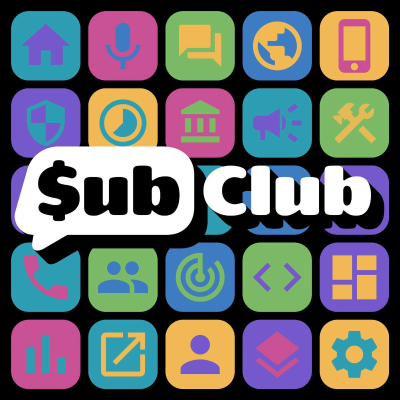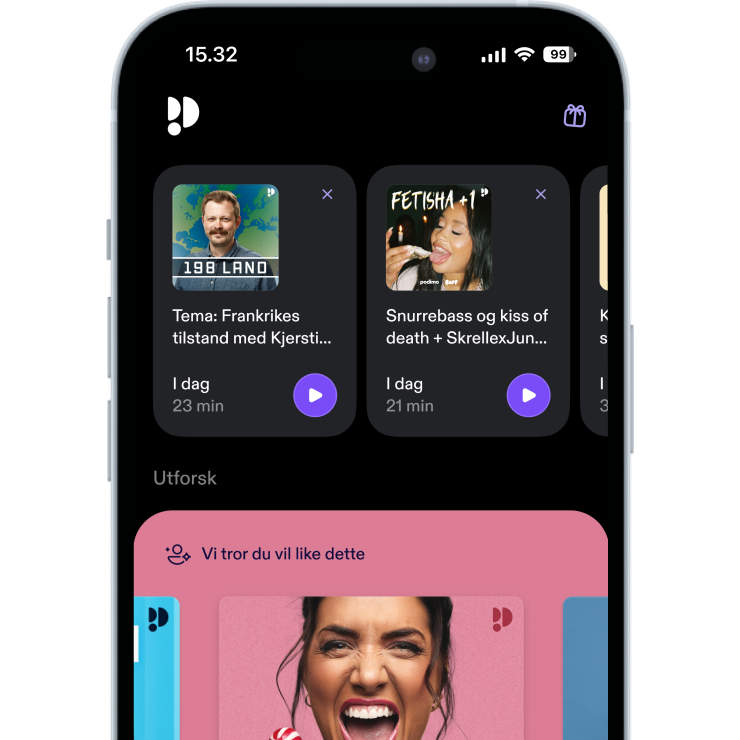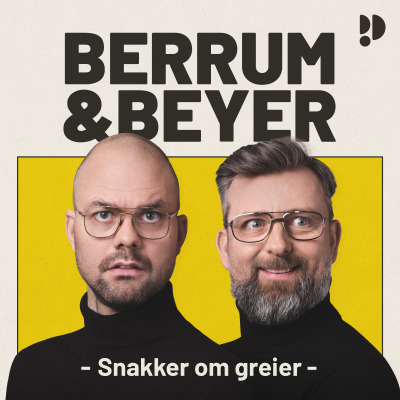
Sub Club by RevenueCat
Podkast av David Barnard, Jacob Eiting
Prøv gratis i 14 dager
99 kr / Måned etter prøveperioden.Avslutt når som helst.

Mer enn 1 million lyttere
Du vil elske Podimo, og du er ikke alene
Rated 4.7 in the App Store
Les mer Sub Club by RevenueCat
Interviews with the experts behind the biggest apps in the App Store. Hosts David Barnard and Jacob Eiting dive deep to unlock insights, strategies, and stories that you can use to carve out your slice of the 'trillion-dollar App Store opportunity'.
Alle episoder
133 EpisoderOn the podcast I talk with John about the fascinating 40-year history of Apple’s developer relations, how almost going bankrupt in the 1990s shaped today’s control-focused approach, and why we might need an ‘App Store 3.0’ reset. Top Takeaways: 🕹️ The 1980s: Apple’s developer DNA was born Apple’s earliest wins came from nurturing third-party developers, even spinning off its own apps to avoid competing with outsiders. 💸 Microsoft saved Apple (literally) Apple’s near-bankruptcy in the ’90s made them both humble and wary—forever shaping how they deal with developers and competition. 🍎 From “please build for us” to “we choose you” WWDC 2008 saw Apple begging for apps and evangelist emails on slides; today, it’s the other way around. 🖥️ The “Delicious Era” fueled iPhone success Mac indie devs (Panic, Delicious Monster, Bare Bones) built a design-obsessed, passionate community—setting the stage for the iPhone App Store boom. 🚪 App Store 1.0: A new world for indies For the first time, solo developers could launch businesses from home. No server costs, no payments hassle—just build, submit, and sell. 🏦 Apple’s rules got stricter as the App Store grew As the App Store became a services giant, the partnership vibe faded. Developers went from partners to “users” of Apple’s marketplace. 📉 App Store math now feels upside down Today, indie devs can pay Apple millions, while giants like Meta pay almost nothing. The fee logic and incentives don’t fit 2025. ⏳ The platform needs an “App Store 3.0” reset John and David call for a new era: lower fees, clearer rules, and Apple acting as a true platform partner—not just a toll booth. 🔄 Developer enthusiasm is Apple’s long-term moat Apple risks becoming a “legacy only” giant if it loses developer goodwill. The most important apps are still built by outsiders. 👥 A generational handoff is coming With Apple’s senior leadership nearing retirement, now is the time to set new priorities: empower developers, invest in the ecosystem, and ensure Apple’s platforms stay vibrant for decades to come. About John Gruber: 🚀 Author of the Daring Fireball [https://daringfireball.net/] blog, host of The Talk Show [https://podcasts.apple.com/us/podcast/the-talk-show-with-john-gruber/id528458508], and co-creator of Markdown [https://en.wikipedia.org/wiki/Markdown]. 🍎 John is a lifelong Apple fan and is passionate about discussing all things iPhone, App Store, and developer relations. 💡 “I feel like Apple is dwelling on the success and the innovation that completely revolutionized the phone industry […] for too long and that they should move on and build something else new.” 👋 Daring Fireball [https://daringfireball.net/contact/] Resources: * Bill Gates in 1984 promoting Apple Macintosh [https://www.youtube.com/watch?v=-5zeJyQ31rM] * Bill Gates on stage with Steve Jobs in 1983 [https://www.youtube.com/watch?v=NVtxEA7AEHg] * The Macintosh Way — Guy Kawasaki [https://guykawasaki.com/books/the-macintosh-way/] * Cocoa Programming for Mac OS X — Aaron Hillegass [https://www.goodreads.com/book/show/2066952.Cocoa_Programming_for_Mac_OS_X] * Daring Fireball [https://daringfireball.net/] Follow us on X: * David Barnard - @drbarnard [https://twitter.com/drbarnard] * Jacob Eiting - @jeiting [https://twitter.com/jeiting] * RevenueCat - @RevenueCat [https://twitter.com/RevenueCat] * SubClub - @SubClubHQ [https://twitter.com/SubClubHQ] Episode Highlights: [0:00] Apple Kremlinology: Why understanding Apple requires a special kind of obsession - and a long memory. [4:58] Fanboys unite: David shares how his love of Apple led him from audio engineer to App Store developer. [8:48] Turning point: John’s link to David’s iPhone mileage app in 2008 helped jumpstart his indie career. [13:37] Joz, Phil, and Eddy: The developer relations and most of the App Store are overseen by three Apple execs who joined in the ‘80s. [17:01] The crossroads: How Apple’s early decision to unbundle first-party apps in the ‘80s encouraged third-party innovation. [21:25] Hands off: Why Apple’s decade-long retreat from building software paved the way for a thriving developer ecosystem. [27:07] Vision parallels: John compares Vision Pro’s slow start to the original Mac - and explains why it doesn’t have to be perfect (yet). [30:32] Betting on the future: How Apple playing the long-game is their biggest advantage in launching and sustaining new platforms. [33:55] What comes after the Mac: The ‘90s were filled with failed next-gen Apple platforms - and it almost killed the company. [36:47] Burned by success: Apple’s trauma from near-bankruptcy shaped their need to control developer relationships. [41:13] The App Store revolution: Why the 2008 launch of the App Store wasn’t just a business move, it was a turning point for software itself. [45:07] Developer momentum: How passionate indie devs and Mac software of the 2000s primed the iPhone for success. [53:46] iPhone jailbreakers: Why the jailbreak community may have pushed Apple to launch the SDK sooner than expected. [57:39] App Store 2.0: In 2016, Apple dropped some commission rates, opened up subscriptions, and kicked off a new era. [1:03:03] Time for 3.0: Why David believes the App Store needs another reset - and a shift in mindset. [1:08:26] Humility and hardware: Steve Jobs’ 1997 apology to a developer at WWDC still echoes - and it’s exactly what developers need to hear in 2025. [1:13:30] Holding on too tight: How Apple’s fear of losing control is costing them developer goodwill. [1:26:35] A legacy worth protecting: The iPhone isn’t going anywhere - but without change, Apple could become a legacy business as other platforms take over. [1:32:06] Red flags on Vision Pro: Why developers aren’t building for Apple’s newest platform - and why that should worry Apple. [1:39:18] The indie paradox: How small developers pay millions to Apple, while giants like Meta pay almost nothing. [1:41:39] Fluke of history: Schiller once floated capping App Store revenue at $1B. What if Jobs had said yes? [1:44:35] The trust gap: Could a more generous App Store policy bring Netflix and others back? [1:47:08] It’s not too late: Why Apple should proactively change the App Store instead of waiting on regulation. [1:57:26] Developer vibes: A simpler App Store (with clearer rules and lower fees) could renew trust and drive innovation. [2:00:29] Bigger than profit: Making great soft...
On the podcast we talk with Eric about his journey from a failed first app to success with his second, the advantage of building for problems people are already talking about, and why he turned down a lucrative acquisition offer to keep building. Top Takeaways: 🔍 Demand-first discipline wins Testing for willingness to pay before writing a line of code can spare you five years of false starts. Quick interviews or landing pages that capture real purchase signals reveal genuine demand—an indispensable early litmus test against building in a vacuum. 🔄 Ride existing habits Rather than convincing users to adopt completely new rituals, plug into behaviors they already practice. When pros were manually measuring holes on satellite maps, the real breakthrough was automating that exact process in real time—sidestepping the steep education curve of a brand-new workflow. 🛑 Bet on a long-term vision, not a quick exit An early $75K acquisition offer can feel like a no-brainer, but sometimes the best move is to walk away. Turning down a strategic buyout kept ownership in entrepreneurial hands and paved the way for multiples of that valuation through continued iteration and growth. 💼 Treat side projects like businesses A side hustle stays a hobby until you put real money on the line. Investing $5K in core data and infrastructure forced a shift from tinkering to professional-grade execution—transforming assumptions into data-driven priorities and unlocking deeper product opportunities. 🤝 Niche community fuel sparks growth No launch strategy outpaces genuine community engagement. By sharing expert tips in specialized forums and social channels before and during build, small audiences morph into early adopters, trial converts, and your most effective brand advocates. Resources * Very Good Ventures [https://verygood.ventures/] (Website) * Seth Miller [https://www.linkedin.com/in/sethmills21/] (LinkedIn) * Curtis Herbert [https://curtisherbert.com/] (LinkedIn) * Eric’s story [https://www.revenuecat.com/blog/growth/why-i-didnt-sell-my-app-shot-pattern-story/] (RevenueCat blog post) Follow us on X: * David Barnard - @drbarnard [https://twitter.com/drbarnard] * Jacob Eiting - @jeiting [https://twitter.com/jeiting] * RevenueCat - @RevenueCat [https://twitter.com/RevenueCat] * SubClub - @SubClubHQ [https://twitter.com/SubClubHQ] Episode Highlights: [3:24] If at first you don’t succeed: How (and when) Eric realized his first app, Undaunted Golf, didn’t have good product-market fit. [7:28] Try, try again: Why Eric’s second golf app, Shot Pattern, was a success. [11:21] If you build it: Instead of just launching on the App Store, Eric implemented a content marketing strategy to promote Shot Pattern. [13:18] Back to black: How Eric’s $5,000 upfront investment in Shot Pattern unlocked some key product differentiators and paid off in a big way. [20:23] Sell, sell, sell?: After receiving an acquisition offer from a potential buyer, Eric used RevenueCat’s app benchmarks to analyze Shot Pattern’s performance data and determine a rough valuation. [25:06] Have a little faith: What happened when Eric turned down a $75,000 buyout offer and kept working on Shot Pattern. [31:25] Video games: How Eric increased Shot Pattern’s annual revenue to $185,000 with video ads. [37:24] Quit your day job: What would make Eric consider quitting his full-time teaching job to focus on his growing subscription app business. [39:18] One-man show: Besides partnering with some content creators, Eric does most of the work for Shot Pattern by himself. [42:25] Success story: How RevenueCat helped Eric launch and grow a successful app business that changed his life.
On the podcast, I talk with Charlie about why Liquid Glass represents a big opportunity for new and existing apps, Apple’s new on-device AI models and their practical limitations, and why the improved App Store Analytics complement rather than replace third-party tools like Appfigures and RevenueCat. Top Takeaways: 🫧 A style refresh is a growth hack A major UI overhaul—like Apple’s new “liquid glass” design—creates a once-in-cycle chance to stand out. Apps that ship the new look on day one dominate screenshots, roundup articles, and “App of the Day” slots. It’s free reach: adopt the guidelines early, respect the new hierarchy (avoid stacking glass on glass), and you can siphon users from slower rivals without a bigger ad budget. 🎯 Keywords deserve their own landing pages You can now pin specific search terms to specific custom product pages. A running-focused page for “5k training,” a cycling page for “bike tracker,” each with its own screenshots and messaging. App Store Connect then breaks analytics down by page, turning guesswork into clear attribution. The result: higher paid-per-download and a shortcut to segment-level A/B testing—no SDK required. ⚡ Tiny, local AI = instant delight Apple’s on-device foundation models aren’t GPT-4, and that’s fine. Their super-fast, private inference (with a 496-token context window) shines at micro-tasks: sentiment tags, quick text rewrites, lightweight image badges, feature-name suggestions. Treat them as edge helpers, not flagship features. For deep research or long context, hand off to a cloud model. Paired wisely, the mix keeps experiences snappy without sacrificing quality. 🪟 Build like screens will fold iPadOS 26 finally lets apps run true windows, offload background work, and juggle tasks like a desktop. That’s great for tablets today and a rehearsal for rumored foldables tomorrow. Audit your layouts: do panes resize gracefully? Can a process finish if the user drags your window aside? Investing in this responsiveness now means you’re launch-ready when new form factors arrive. 🔑 Promotions should be measurable Offer codes used to be subscription-only; now they work for consumables and one-time purchases too. You get up to ten trackable code groups (each with up to a million codes) plus UTM-style links and the expanded App Store analytics to see which podcast promo, TikTok ad, or partner giveaway actually drove revenue. You can finally run seasonal sales or affiliate deals without duct-tape spreadsheets and double down on what moves the needle. About Charlie Chapman: 👟 Senior Developer Advocate at RevenueCat and indie app creator behind a suite of iOS and macOS tools. 🎯 Charlie blends indie instincts with platform insight, translating Apple’s latest changes into real opportunities for developers. 💡 “Don’t build a chatbot around this (on-device models). But if you’re looking for a fast, free way to make your app better in small, thoughtful ways, the new on-device models are really interesting.” 👋 LinkedIn [https://www.linkedin.com/in/charliemchapman/] Follow us on X: * David Barnard - @drbarnard [https://twitter.com/drbarnard] * Jacob Eiting - @jeiting [https://twitter.com/jeiting] * RevenueCat - @RevenueCat [https://twitter.com/RevenueCat] * SubClub - @SubClubHQ [https://twitter.com/SubClubHQ]
On the podcast we talk with Charlie about why React Native has become the default for VC-funded apps, how AI is accelerating development cycles, and why speed of iteration matters more than programming language. Top Takeaways: ⚡ Instant iteration cycles unlock agility React Native and Expo supercharge development by collapsing long build times into mere seconds. With tools like Expo Go enabling live updates, teams can experiment, test, and improve their apps in real time. This instant feedback loop fuels innovation, cuts dev time, and helps startups move faster than ever. 🧱 React Native unifies teams and code By choosing a cross-platform stack like React Native, companies can maintain a single codebase for iOS, Android, and web. This unified approach reduces silos, simplifies hiring, and streamlines development. The result is faster feature delivery, consistent UX, and the agility that startups need to scale. 📈 Iteration speed drives growth Shipping faster beats obsessing over tech stacks. Companies that iterate quickly can test ideas, learn from real users, and ship improvements faster than competitors. This leads to better products, higher retention, and stronger monetization, giving them a competitive edge in crowded markets. 🔍 Consistency across platforms builds trust Users expect apps to work seamlessly, whether they’re on iOS, Android, or the web. React Native helps deliver that uniform experience, aligning with modern product expectations. Consistency reduces friction, boosts trust, and enhances user satisfaction—key drivers of long-term growth. 🤝 AI is the co-pilot, humans set the course AI tools like Claude and Copilot are transforming app development, making it faster to scaffold code and build features. But the real breakthroughs come from human oversight—making smart UX decisions, handling platform quirks, and bringing creative problem-solving. Pairing AI speed with human insight unlocks the best of both worlds. About Charlie Cheever: 🚀 Co-Founder and CEO of Expo [https://expo.dev/], a platform that simplifies the development of native apps using React Native, empowering developers to build apps for iOS, Android, and the web with ease. 📱 Charlie is dedicated to empowering developers to create seamless, cross-platform apps with less friction. He’s focused on improving the developer experience by reducing complexity and enabling rapid iteration. 💡 “One of the biggest advantages of Expo and React Native is the ability to move fast and iterate quickly without worrying about maintaining separate codebases for each platform. 👋 LinkedIn [https://www.linkedin.com/in/ccheever/] Resources: * State of Subscription Apps 2025 — RevenueCat Report [https://www.revenuecat.com/state-of-subscription-apps-2025/] Follow us on X: * David Barnard - @drbarnard [https://twitter.com/drbarnard] * Jacob Eiting - @jeiting [https://twitter.com/jeiting] * RevenueCat - @RevenueCat [https://twitter.com/RevenueCat] * SubClub - @SubClubHQ [https://twitter.com/SubClubHQ] Episode Highlights: [1:12] Chain reaction: What React [https://react.dev/] is and how Expo [https://expo.dev/] enables developers to use it. [6:30] Positive feedback loop: How Expo dramatically shortens the product development and iteration cycle. [12:08] React vs. native: Why React [https://react.dev/] has become the default development framework for modern apps and websites — enabling seamless product iteration across platforms with fewer engineering resources. [23:13] 1+3+4: How Bluesky [https://bsky.app/] was built for three platforms by one developer in just four months. [28:07] All-in: Why it’s better to build with React from the start instead of developing a native app first and implementing React later. [35:20] Cause/effect: Do React Native subscription apps monetize better than native apps? [39:37] Coding smarter: How AI is speeding up development times and pushing developers towards rapid-iteration tools like Expo. [58:52] Mobile shift: More and more people are consuming software on mobile devices instead of PCs… shouldn’t the app development process align with that shift?
On the podcast I talk with Tim about the importance of trust in web2app funnels, replacing free trials with money-back guarantees, and how they’ve found success with contractors after struggling with in-house marketing hires. Top Takeaways: 🔁 Replace trials with trust to attract high-intent users A 30-day money-back guarantee can outperform traditional free trials—especially in web funnels. Paying upfront sends a stronger signal to ad platforms, helping them optimize for the right users. And when refunds are rare, overall LTV improves. It’s a bet on product confidence and customer intent. 🧑🤝🧑 Learning apps work better when parents are part of the experience Apps that require co-use between a parent and child show far better educational outcomes and retention. Research shows kids learn up to 19x more effectively with adult involvement. It’s a smaller market—but a deeper one—if you design for it. 🏗️ Rigid methods can stifle product innovation Strict adherence to frameworks like Scrum can turn creative engineers into ticket-takers. Giving teams room to rethink and revise—even late in development—yields stronger products. Empower developers as collaborators, not executors. 🌐 Trusted domains outperform in web-to-app conversion When onboarding flows are moved to the web, conversion often drops—unless users recognize and trust the brand. Memorable, credible domains help users feel confident making purchases off-platform. Trust is the friction reducer. 🧰 Specialized contractors deliver more with less overhead Instead of building an in-house team of marketing generalists, using seasoned channel experts—paid media, lifecycle, SEO—can deliver faster results with less management. It’s a scalable model for lean teams aiming to punch above their weight. About Tim Dikun: 🧑🏫COO of Teaching.com [http://teaching.com], a suite of educational apps for children that’s been helping kids learn to read and type for nearly 30 years. 📖 Tim is passionate about building world-class educational tools that leverage both the power of AI and the parent-child connection. 💡“There's a lot of tooling out there for mobile apps that we just can't use because Apple won't let us — because it's a kids’ app. And I get it, it makes sense. It just means we have to get a little creative and find ways to get the information that we're looking for.” 👋 LinkedIn [https://www.linkedin.com/in/timdikun/] Follow us on X: * David Barnard - @drbarnard [https://twitter.com/drbarnard] * Jacob Eiting - @jeiting [https://twitter.com/jeiting] * RevenueCat - @RevenueCat [https://twitter.com/RevenueCat] * SubClub - @SubClubHQ [https://twitter.com/SubClubHQ] Episode Highlights: [0:37] Storied history: How Teaching.com found product-market fit in the early days of subscription apps. [4:41] (A)syncing up: Why Teaching.com disables Slack and Basecamp notifications in their team communications. [8:12] Ch-ch-ch-changes: Teaching.com’s approach to product development encourages ideation and late-stage changes, rather than sticking to an arbitrary design. [11:48] Intelligence (artificial and otherwise): Finding the right balance between AI and the human touch in an educational product. [15:40] Testing the waters: Experimenting with higher prices, money-back guarantees, and annual plans to increase LTV. [23:03] Context switching: Teaching.com’s experiments with web-to-app resulted in a 50% increase in trial starts and a 30% increase in paid conversions. [28:35] Upselling: Increasing LTV with downloadable in-app purchases and physical products on Amazon. [33:02] Land and expand: Increasing the size and LTV of your user base by serving additional customer needs. [35:34] Kid-friendly: The unique challenges of developing subscription apps for children. [38:36] Expert advice: Why Teaching.com contracts with marketing channel experts instead of building an in-house marketing team.

Rated 4.7 in the App Store
Prøv gratis i 14 dager
99 kr / Måned etter prøveperioden.Avslutt når som helst.
Eksklusive podkaster
Uten reklame
Gratis podkaster
Lydbøker
20 timer i måneden

































